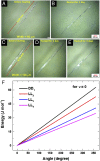Chirality-controlled spontaneous twisting of crystals due to thermal topochemical reaction
- PMID: 29507233
- PMCID: PMC5866578
- DOI: 10.1073/pnas.1718965115
Chirality-controlled spontaneous twisting of crystals due to thermal topochemical reaction
Abstract
Crystals that show mechanical response against various stimuli are of great interest. These stimuli induce polymorphic transitions, isomerizations, or chemical reactions in the crystal and the strain generated between the daughter and parent domains is transcribed into mechanical response. We observed that the crystals of modified dipeptide LL (N3-l-Ala-l-Val-NHCH2C≡CH) undergo spontaneous twisting to form right-handed twisted crystals not only at room temperature but also at 0 °C over time. Using various spectroscopic techniques, we have established that the twisting is due to the spontaneous topochemical azide-alkyne cycloaddition (TAAC) reaction at room temperature or lower temperatures. The rate of twisting can be increased by heating, exploiting the faster kinetics of the TAAC reaction at higher temperatures. To address the role of molecular chirality in the direction of twisting the enantiomer of dipeptide LL, N3-d-Ala-d-Val-NHCH2C≡CH (DD), was synthesized and topochemical reactivity and mechanoresponse of its crystals were studied. We have found that dipeptide DD not only underwent TAAC reaction, giving 1,4-triazole-linked pseudopolypeptides of d-amino acids, but also underwent twisting with opposite handedness (left-handed twisting), establishing the role of molecular chirality in controlling the direction of mechanoresponse. This paper reports (i) a mechanical response due to a thermal reaction and (ii) a spontaneous mechanical response in crystals and (iii) explains the role of molecular chirality in the handedness of the macroscopic mechanical response.
Keywords: chirality; mechanoresponsive crystals; spontaneous; topochemical reactions; twisting.
Conflict of interest statement
The authors declare no conflict of interest.
Figures






References
-
- Naumov P, Chizhik S, Panda MK, Nath NK, Boldyreva E. Mechanically responsive molecular crystals. Chem Rev. 2015;115:12440–12490. - PubMed
-
- Nath NK, Panda MK, Sahoo SC, Naumov P. Thermally induced and photoinduced mechanical effects in molecular single crystals—A revival. CrystEngComm. 2014;16:1850–1858.
-
- Lan T, Chen W. Hybrid nanoscale organic molecular crystals assembly as a photon-controlled actuator. Angew Chem Int Ed Engl. 2013;52:6496–6500. - PubMed
-
- Shima T, et al. Thermally driven polymorphic transition prompting a naked-eye-detectable bending and straightening motion of single crystals. Angew Chem Int Ed Engl. 2014;53:7173–7178. - PubMed
-
- Garcia-Garibay MA. Molecular crystals on the move: From single-crystal-to-single-crystal photoreactions to molecular machinery. Angew Chem Int Ed Engl. 2007;46:8945–8947. - PubMed
Publication types
LinkOut - more resources
Full Text Sources
Other Literature Sources

